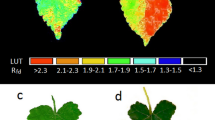Abstract
A test was developed that measures in vivo chlorophyll afluorescence variables to assess the apparent sensitivity of freshwaterperiphytic algae to photosystem II inhibitors. Natural periphyticcommunities from rivers were collected on artificial substrata, and theeffects of short-term exposures to two PSII herbicides (atrazine andisoproturon) on the fluorescence parameters were measured with apulse-amplitude modulated fluorometer. The EC50 for each herbicide werecalculated from fluorescence yield indices, and these results were comparedto 14C-based primary production measurements on the samecommunities. The fluorescence-based method appears to give very reliableestimations of EC50 for each pesticide we tested, ranging from 0.46 to5.18 μM and 0.07 to 6.77 μM for atrazine and isoproturon,respectively. This method could be used in ecotoxicology monitoringprograms, to detect changes in natural periphyton populations sensitivity,following photosystem II herbicide contamination in rivers or lakes.
Similar content being viewed by others
References
Blanck H (1985) A simple, community level, ecotoxicological test system using samples of periphyton. Hydrobiologia 124: 251-261.
Bonin DJ, Travers M (1992) Examen critique des méthodes d'estimation de la biomasse et de l'activité des microorganismes dans les systèmes aquatiques. Mar. Life 2: 1-29.
Briggs BJF, Goring DG, Nikora VI (1998) Subsidy and stress responses of stream periphyton to gradients in water velocity as a function of community growth form. J. Phycol. 34: 598-607.
Cattaneo A, Amireault MC (1992) How artificial are artificial substrata for periphyton ? J. North Am. benthol. Soc. 11: 244-256.
Cattaneo A, Kerimian T, Roberge M, Marty J (1997) Periphyton distribution and abundance on substrata of different size along a gradient of stream trophy. Hydrobiologia 354: 101-110.
Conrad R, Büchel C, Wilhelm C, Arsalane W, Berkaloff C, Duval JC (1993) Changes in yield of in vivo fluorescence as a tool for selective herbicide monitoring. J. appl. Phycol. 5: 505-516.
Goldsborough LG, Robinson GGC (1986) Changes in periphytic algal community structure as a consequence of short herbicide exposures. Hydrobiologia 139: 177-192.
Guasch H, Ivorra N, Lehmann V, Paulsson M, Real M, Sabater S (1998) Community composition and sensitivity of periphyton to atrazine in flowing waters: the role of environmental factors. J. appl. Phycol. 10: 203-213.
Guasch H, Muñoz I, Rosés N, Sabater S (1997) Changes in atrazine toxicity throughout succession of stream periphyton communities. J. appl. Phycol. 9: 137-146.
Guasch H, Sabater S (1998) Light history influences the sensitivity to atrazine in periphytic algae. J. Phycol. 34: 233-241.
Herman D, Kaushik NK, Solomon KR (1986) Impact of atrazine on periphyton in freshwater enclosures and some ecological consequences. Can. J. Fish aquat. Sci. 43: 1917-1925.
Juneau P, Popovic R (1999) Evidence for the rapid phytotoxicity and environmental stress evaluation using the PAM fluorometric method: importance in future application. Ecotoxicology 8: 449-455.
Kirby MF, Sheanhan DA (1994) Effects of atrazine, isoproturon, and mecoprop on the macrophyte Lemna minor and the alga Scenedesmus subspicatus. Bull. environ. Contam. Toxicol. 53: 120-126.
Kromkamp J, Barranguet C, Peene J (1998) Determination of microphytobenthos PSII quantum efficiency and photosynthetic activity by means of variable chlorophyll fluorescence. Mar. Ecol. Progr. Ser. 162: 45-55.
Maxwell K, Johnson GN (2000) Chlorophyll fluorescence-a practical guide. J. exp. Bot. 51: 659-668.
McCormick PV, Cairns J, Jr (1994) Algae as indicators of environmental changes. J. appl. Phycol. 6: 509-526.
Nyholm N (1990) Expression of results from growth inhibition toxicity tests with algae. Arch. environ. Contam. Toxicol. 19: 518-522.
Nyström B, Paulsson M, Almgren K, Blanck H (2000) Evaluation of the capacity for development of atrazine tolerance in periphyton from a Swedish freshwater site as determined by inhibition of photosynthesis and sulfolipid synthesis. Environ. Toxicol. Chem. 19: 1324-1331.
Pereira WE, Rostad CE (1990) Occurrence, distribution and transport of herbicides and their degradation products in the lower Mississippi River and its tributaries. Environ. Sci. Technol. 24: 1400-1406.
Petersen S, Kusk KO (2000) Photosynthesis as an alternative to growth tests for hazard assessment of toxicant. Arch. environ. Contam. Toxicol. 38: 152-157.
Samson G, Popovic R (1988) Use of algal fluorescence for determination of phytotoxicity of heavy metals and pesticides as environmental pollutants. Ecotoxicol. environ. Safety 16: 272-278.
Schreiber U, Schliwa U, Bilger W (1986) Continuous recording of photochemical and non-photochemical fluorescence quenching with a new type of modulation fluorometer. Photosynth. Res. 10: 51-62.
Seguin F, Leboulanger C, Rimet F, Druart JC, Bérard A (2001) Effects of atrazine and nicosulfuron on phytoplankton in systems of increasing complexity. Arch. environ. Contam. Toxicol. 40: 198-208.
Solomon KR, Baker DB, Richards P, Dixon KR, Klaine SJ, LaPoint TW, Kendall RJ, Weisskopf CP, Giddings JM, Giesy JP, Hall LW, Jr, Williams WM (1996) Ecological risk assessment of atrazine in North American surface waters. Environ. toxicol. Chem. 15: 31-76.
Wilhelm C, Conrad R, Meitzler L, Mühlenweg A (1996) Combination of solid phase extraction and a microalgal test system based on pulse-amplitude modulated fluorescence to detect photosystem II herbicides up to 0.05 µeq l-1. J. appl. Phycol. 8: 171-173.
Wilhelm C, Rudolph I, Renner W (1991) A quantitative method based on HPLC-aided pigment analysis to monitor structure and dynamics of the phytoplankton assemblage-A study from Lake Meerfelder Mar (Eifel, Germany). Arch. Hydrobiol. 123: 21-35.
Wright SW, Jeffrey SW (1997) High-resolution HPLC system for chlorophylls and carotenoids of marine phytoplankton. In Jeffrey SW, Mantoura RFC, Wright SW (eds), Phytoplankton Pigments in Oceanography, UNESCO-SCOR, Paris, pp. 327-341.
Author information
Authors and Affiliations
Rights and permissions
About this article
Cite this article
Dorigo, U., Leboulanger, C. A pulse-amplitude modulated fluorescence-based method for assessing the effects of photosystem II herbicides on freshwater periphyton. Journal of Applied Phycology 13, 509–515 (2001). https://doi.org/10.1023/A:1012598816581
Issue Date:
DOI: https://doi.org/10.1023/A:1012598816581




